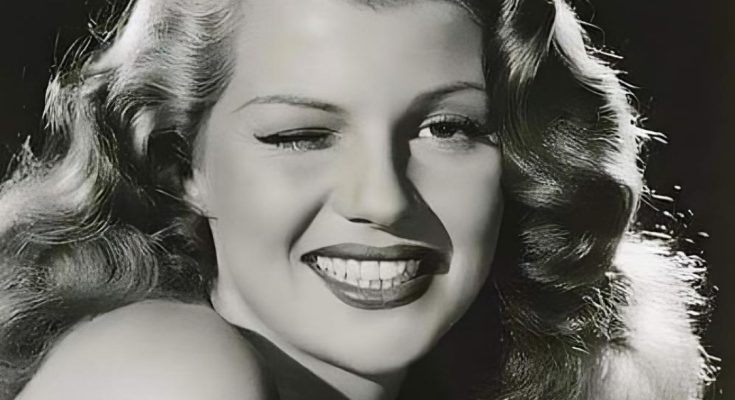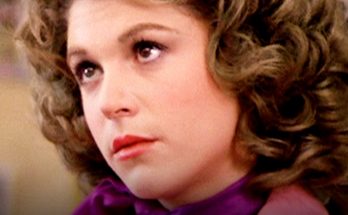Rita Hayworth, famously dubbed the “Goddess of Love,” became one of Hollywood’s biggest stars and the most desired screen icon of the 1940s. Her image graced the lockers of American soldiers during World War II, and her films made her a household name. Yet, behind her glamorous facade, Hayworth’s life was marked by turmoil, pain, and relentless misfortune.
The Early Years: A Childhood Stolen by Fame

Born Margarita Carmen Dolores Cansino on October 17, 1918, in New York City, Rita grew up under the strict gaze of her father, Eduardo Cansino, a Spanish flamenco dancer. Her father saw her talent early on and forced her into a life of brutal dance training. As she would later recall, “Practice, practice, practice. That was my youth.” At the age of 12, Eduardo pulled her out of school, making her his dance partner on stages across Mexico and California.
During these years, Hayworth’s life became entangled in secrets and darkness. It was only years later, through an interview with her former husband, Orson Welles, that the full horror of her childhood abuse at the hands of her father came to light.
First Steps into Hollywood: From Margarita to Rita
In 1935, a 16-year-old Hayworth was discovered by a Fox producer while dancing in a club. Her talent earned her small roles, and soon she appeared in films such as Under the Pampas Moon and Charlie Chan in Egypt. But it wasn’t until she met Edward Charles Judson, a man who presented himself as a wealthy Texan, that her career truly took off.
Judson, who later became her first husband, transformed her from Margarita Cansino to Rita Hayworth. He convinced her to dye her black hair to a sultry auburn, raise her hairline with painful electrolysis, and change her eyebrows—all to make her look more “American.” Although Judson’s manipulation helped her career, it was the beginning of a cycle where men used and exploited her.
The Rise to Stardom: Becoming “Gilda”
After several minor roles, Hayworth signed with Columbia Pictures, where her career reached new heights. Her performance alongside Cary Grant in Only Angels Have Wings marked her arrival, but it was her role as Gilda in 1946 that made her a star. The image of her character in Gilda, seductively flipping her hair, solidified her as a Hollywood sex symbol. The film’s success brought her global fame, yet Hayworth would later admit, “Gilda became a hindrance because I was made to look a certain way.” Though adored by fans, Hayworth felt trapped by her own image.

A Tumultuous Love Life: Five Marriages and Heartbreaks
Hayworth’s personal life was as tumultuous as her career was successful. Her five marriages, each bringing a different form of betrayal or disappointment, only added to her emotional struggles.
- Edward Judson (1937–1942): Judson, her first husband, viewed her as an “investment” and controlled every aspect of her career. After years of emotional abuse, she finally left him.
- Orson Welles (1943–1947): Welles was her second husband, and though he was one of the few men she truly loved, their marriage was plagued by infidelity and control issues. Welles introduced her to books and attempted to shape her mind, but his own ambitions kept him distant.
- Prince Aly Khan (1949–1953): Hayworth’s third marriage was to Prince Aly Khan, marking the first time a major Hollywood star married into royalty. However, their relationship was marred by infidelity, and their cultural differences were too much to overcome. They had one daughter, Princess Yasmin.
- Dick Haymes (1953–1955): Known as “Mr. Evil” in Hollywood, Haymes was abusive and financially irresponsible. He drained her wealth and physically assaulted her, leading to a hasty divorce.
- James Hill (1958–1961): Her fifth marriage, to director James Hill, initially seemed promising. But he too became abusive, both physically and emotionally. After several violent incidents, she ended the marriage.

The Later Years: Fighting Inner Demons
In her later years, Hayworth’s struggles only intensified. She felt isolated in Hollywood, a symbol of an era that had begun to fade. She struggled with alcoholism, which many believe was a coping mechanism for the trauma and abuse she had endured. Despite being a household name, she struggled with poverty and mental health issues.
In 1980, she was diagnosed with Alzheimer’s disease, though many had mistaken her symptoms for alcoholism. The disease took a toll on her career and relationships. By the end of her life, Hayworth couldn’t remember her iconic roles or her life as one of Hollywood’s biggest stars.

Legacy: Remembering a Goddess of the Screen
Rita Hayworth passed away on May 14, 1987. She left behind an unforgettable legacy and a collection of films that immortalized her beauty and talent. Despite her tragic life, she is remembered as a Hollywood legend, a “Goddess of Love” who captivated audiences and became an enduring icon. Her legacy is a reminder of the dark underbelly of fame and the resilience of a woman who survived it all, albeit at great personal cost.



